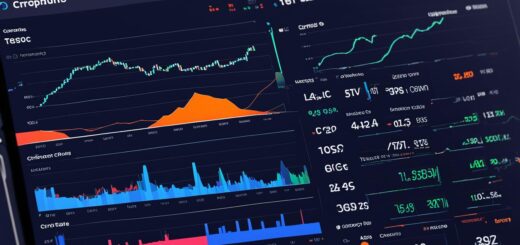The Ultimate Guide to Crypto Trading
Are you ready to embark on an exciting journey into the world of crypto trading? Look no further, because “The Ultimate Guide to Crypto Trading” is here to equip you with all the knowledge and strategies you need to navigate this fast-paced and exhilarating market. From understanding the basics of cryptocurrencies to mastering technical analysis, this comprehensive guide will empower you to make informed decisions and maximize your potential for success. Get ready to unlock the secrets of crypto trading and join the ranks of savvy traders who are taking advantage of this lucrative opportunity.

Understanding Crypto Trading
What is Crypto Trading?
Crypto trading refers to the buying, selling, and exchanging of cryptocurrencies in order to make a profit. Cryptocurrencies are digital or virtual currencies that use cryptography for security and operate on decentralized networks called blockchains. Unlike traditional fiat currencies, cryptocurrencies are not issued or regulated by any central authority such as a government or financial institution.
The Basics of Cryptocurrencies
Before diving into crypto trading, it is essential to have a solid understanding of cryptocurrencies themselves. Cryptocurrencies are typically created through a process called mining, where powerful computers solve complex mathematical problems. The most well-known cryptocurrency is Bitcoin, but there are thousands of other cryptocurrencies available for trading.
Cryptocurrencies are stored in digital wallets and can be transferred between individuals using public and private keys. Each transaction is recorded on the blockchain, which ensures transparency and prevents fraud. The value of cryptocurrencies is determined by supply and demand dynamics in the market.
The Differences Between Crypto Trading and Traditional Trading
Crypto trading differs from traditional trading in several aspects. Firstly, crypto markets operate 24/7, whereas traditional markets have set opening and closing hours. Additionally, traditional trading relies on fiat currencies such as the US dollar or Euro, while crypto trades are often conducted using Bitcoin or other cryptocurrencies.
Another key difference is the level of regulation. Traditional financial markets are heavily regulated by government bodies, while crypto markets are relatively unregulated. This lack of regulation can lead to greater volatility and risks in the crypto market.
Getting Started with Crypto Trading
Setting Up a Crypto Exchange Account
To begin crypto trading, the first step is to set up an account on a crypto exchange platform. There are numerous crypto exchanges available, each with its own features, fees, and security measures. It is important to choose a reputable and secure exchange that aligns with your trading goals.
During the account setup process, you will typically need to provide personal information and verify your identity. This is part of the exchange’s know-your-customer (KYC) process to prevent money laundering and comply with legal requirements.
Choosing the Right Cryptocurrencies to Trade
With thousands of cryptocurrencies to choose from, it is important to select the right ones to trade. Factors to consider include the project’s technology, team, market capitalization, trading volume, and overall market sentiment. Conducting thorough research and staying updated with crypto news can help you make informed decisions.
It is generally advisable to start with well-established cryptocurrencies such as Bitcoin, Ethereum, or Ripple, as they tend to be more stable and have higher liquidity. As you gain experience and confidence, you can explore trading smaller or newly launched cryptocurrencies with higher growth potential.
Understanding Market Analysis
Market analysis is a critical skill for successful crypto trading. It involves studying historical price data, market trends, and other indicators to predict future price movements. There are two primary methods of market analysis: technical analysis and fundamental analysis.
Technical analysis utilizes historical price charts, patterns, and various technical indicators to identify potential trading opportunities. It aims to uncover patterns and trends in the market to predict future price movements. On the other hand, fundamental analysis focuses on evaluating the intrinsic value of a cryptocurrency by analyzing factors such as the project’s technology, team, partnerships, and overall market conditions.
Developing a Trading Strategy
Types of Trading Strategies
When it comes to crypto trading, having a well-defined trading strategy is essential. A trading strategy is a set of rules and guidelines that determine when to enter and exit trades. There are several popular trading strategies to consider:
-
Scalping: This strategy involves making small profits from short-term price fluctuations. Traders using this strategy aim to enter and exit positions quickly, often within minutes or even seconds.
-
Day Trading: Day traders aim to profit from intraday price movements and typically close all their positions before the market closes for the day. This strategy requires closely monitoring the market throughout the day and making quick decisions.
-
Swing Trading: Swing traders aim to profit from medium-term price swings that can last from a few days to several weeks. They analyze both technical and fundamental factors to identify potential entry and exit points.
-
Position Trading: Position traders take a longer-term approach and hold their positions for weeks, months, or even years. They analyze the overall market trends and focus on the long-term potential of a cryptocurrency.
Technical Analysis vs. Fundamental Analysis
Both technical analysis and fundamental analysis have their merits, and many traders use a combination of both. Technical analysis focuses on price patterns and indicators, while fundamental analysis looks at the underlying factors that could influence a cryptocurrency’s value.
Technical analysis is particularly useful for short-term traders who are interested in identifying market trends and making quick profits. It involves studying price charts, patterns such as support and resistance levels, and various technical indicators like moving averages and oscillators.
Fundamental analysis, on the other hand, is more suitable for long-term traders who want to understand the value and potential of a cryptocurrency. It involves analyzing the project’s technology, team, partnerships, market demand, and other external factors that could impact its price.
Choosing the Right Timeframe
When developing a trading strategy, it is important to choose the right timeframe that aligns with your trading goals and personality. Different timeframes offer different advantages and disadvantages.
Shorter timeframes, such as minutes or hours, are suitable for day traders and scalpers who aim to profit from short-term price fluctuations. These shorter timeframes require constant monitoring and quick decision-making.
Longer timeframes, such as days or weeks, are more suitable for swing traders and position traders who take a more relaxed approach and aim to capture larger price movements. These timeframes allow for less frequent decision-making and more in-depth analysis.
To determine the right timeframe for your trading strategy, consider factors such as your availability, risk tolerance, and trading style.
Managing Risk in Crypto Trading
Risk Management Techniques
Managing risk is crucial in crypto trading, as the market can be highly volatile and unpredictable. Implementing sound risk management techniques can help protect your capital and minimize potential losses.
One commonly used risk management technique is setting a stop-loss order. A stop-loss order automatically sells a cryptocurrency when its price reaches a predefined level, limiting potential losses. Traders typically set their stop-loss orders at a certain percentage below their entry price.
Another technique is diversifying your portfolio. By spreading your investments across multiple cryptocurrencies, you reduce the risk of significant losses if one particular cryptocurrency performs poorly. Diversification allows you to take advantage of different opportunities and hedge against potential risks.
Setting Stop-Loss and Take-Profit Orders
Stop-loss and take-profit orders are essential tools in managing risk and ensuring disciplined trading. A stop-loss order is placed below the current market price and is triggered when the price reaches or falls below the specified level. This prevents further losses if the market moves in an unfavorable direction.
A take-profit order, on the other hand, is placed above the current market price and is triggered when the price reaches or exceeds the specified level. This enables you to lock in profits and exit your position when the market reaches your desired target.
It is important to determine appropriate levels for both your stop-loss and take-profit orders based on your risk tolerance, trading strategy, and market analysis.
Diversifying Your Portfolio
Diversifying your crypto trading portfolio is a crucial risk management strategy. By investing in a variety of cryptocurrencies across different sectors and market caps, you reduce the risk of being heavily affected by the performance of a single cryptocurrency.
Diversification allows you to take advantage of different market conditions and potential opportunities. It is important to research and analyze the cryptocurrencies you choose to include in your portfolio, ensuring they have unique value propositions and strong growth potential.
However, it is also important to strike a balance between diversification and overexposure. Investing in too many cryptocurrencies can become overwhelming and hinder your ability to effectively track and manage your investments.

Executing Crypto Trades
Types of Orders in Crypto Trading
When executing trades in the crypto market, there are several types of orders to choose from:
-
Market Order: A market order is executed immediately at the current market price. This type of order ensures quick execution but provides no control over the exact price at which the trade is executed.
-
Limit Order: A limit order allows you to set a specific price at which you are willing to buy or sell a cryptocurrency. The trade is only executed when the market reaches your specified price or better.
-
Stop Order: A stop order is used to trigger a market order when the price reaches or exceeds a specified level. It is commonly used to limit losses or enter a trade once a certain price is reached.
-
Stop-Limit Order: A stop-limit order combines elements of both stop and limit orders. It involves setting a stop price and a limit price. When the stop price is reached, a limit order is placed at the specified limit price.
Understanding Order Books and Liquidity
Order books play a vital role in the crypto market by providing transparency and enabling traders to place buy and sell orders. An order book is a list of all the buy and sell orders for a particular cryptocurrency, organized by price and quantity.
The order book consists of two main sections: the bid section and the ask section. The bid section shows the current highest buying prices, while the ask section shows the current lowest selling prices. The orders in the order book represent the supply and demand dynamics of the market.
Liquidity refers to the ease of buying or selling a cryptocurrency without affecting its price significantly. Higher liquidity generally indicates a more active market and allows for smoother and faster execution of trades. Lower liquidity, on the other hand, can result in slippage and higher trading costs.
Market Orders vs. Limit Orders
Market orders and limit orders are two common types of orders used in crypto trading, each with its own advantages and considerations.
A market order is executed at the current market price, ensuring immediate execution. This type of order is suitable when speed is a priority and you are willing to accept the current market price. However, market orders may be subject to slippage, which occurs when the executed price differs from the expected price due to market volatility.
A limit order, on the other hand, allows you to set a specific price at which you are willing to buy or sell a cryptocurrency. This gives you more control over the execution price, but there is no guarantee that the trade will be executed if the market does not reach your specified price.
The choice between market orders and limit orders depends on your trading strategy, risk tolerance, and market conditions.
Tools and Indicators for Crypto Trading
Candlestick Charts
Candlestick charts are a popular and widely used tool in crypto trading. They provide visual representations of price movements over a given period of time. Each candlestick represents a specific timeframe, such as minutes, hours, or days.
Candlestick charts display the opening price, closing price, highest price, and lowest price within a timeframe. The color of the candlestick indicates whether the price closed higher (typically represented by a green or white candlestick) or lower (typically represented by a red or black candlestick) than the opening price.
Candlestick patterns can provide valuable insights into market sentiment and potential price reversals. Traders often use candlestick patterns to identify buying and selling opportunities.
Moving Averages
Moving averages are technical indicators used to smooth out price fluctuations and identify trends. They calculate the average price over a specified period of time and plot the result on the price chart.
Two commonly used moving averages are the simple moving average (SMA) and the exponential moving average (EMA). The SMA gives equal weight to all prices in the specified period, while the EMA places more weight on recent prices.
Moving averages help traders identify potential support and resistance levels, as well as trend reversals. They can be used individually or in combination with other indicators to make informed trading decisions.
Relative Strength Index (RSI)
The Relative Strength Index (RSI) is a momentum oscillator that measures the speed and change of price movements. It ranges from 0 to 100 and is often used to identify overbought and oversold conditions in the market.
The RSI compares the magnitude of recent gains versus losses to determine whether a cryptocurrency is overbought or oversold. When the RSI reading is above 70, it typically indicates that the cryptocurrency is overbought and may be due for a price correction. Conversely, an RSI reading below 30 suggests that the cryptocurrency is oversold and may experience a potential price increase.
Traders use the RSI as a tool to identify potential entry and exit points, as well as to confirm or contradict other technical indicators.
Bollinger Bands
Bollinger Bands are volatility indicators that consist of a middle band (typically a moving average) and two outer bands that are placed above and below the middle band. The outer bands represent standard deviations of price volatility.
Bollinger Bands expand and contract based on market volatility. When the bands widen, it indicates increased volatility, while contraction suggests decreased volatility. Traders use Bollinger Bands to identify periods of low volatility followed by potential breakout opportunities.
When a cryptocurrency’s price moves close to or beyond the upper or lower band, it may signal potential overbought or oversold conditions. However, it is important to consider other technical indicators and market fundamentals before making trading decisions.
Fibonacci Retracement
Fibonacci retracement is a technical analysis tool based on the idea that markets often retrace a portion of a previous price movement before continuing in the same direction. It utilizes a sequence of numbers known as the Fibonacci sequence, where each number is the sum of the two preceding numbers.
Fibonacci retracement levels are horizontal lines that indicate potential support and resistance areas. The main levels are 23.6%, 38.2%, 50%, 61.8%, and 78.6%. Traders use these levels as possible entry or exit points, as well as to identify potential price reversals.
The Fibonacci retracement tool is widely utilized by traders to determine the potential retracement levels after a significant price movement. It is often used in conjunction with other technical indicators to confirm trading signals.
Volume Analysis
Volume is a crucial indicator in crypto trading as it reflects the number of shares or contracts traded in a given period. It helps gauge the strength, reliability, and sustainability of a price movement.
High volume during a price uptrend indicates strong buying pressure, while low volume during an uptrend may suggest weakening momentum. Conversely, high volume during a downtrend indicates strong selling pressure, while low volume during a downtrend might indicate a potential trend reversal.
Volume analysis is often used to confirm price trends, identify potential breakouts or reversals, and assess the overall market sentiment.
Monitoring and Tracking Trades
Using Trading Platforms and Mobile Apps
To effectively monitor and track your trades, it is essential to use reliable trading platforms and mobile apps. These platforms provide real-time market data, order execution capabilities, and various charting tools and indicators.
Choose a trading platform that offers a user-friendly interface, advanced charting capabilities, and robust security measures. Mobile apps are particularly useful for traders who need to access their trades and market information on the go.
Ensure that the trading platform or app you choose supports the cryptocurrencies you are interested in trading and provides adequate customer support.
Tracking Price Movements
Tracking price movements is a fundamental aspect of crypto trading. It involves monitoring the price of the cryptocurrencies you are trading and identifying potential entry and exit points based on your trading strategy and market analysis.
There are several ways to track price movements, including using price charts, setting price alerts, and following real-time market data. Price charts provide a visual representation of price movements over time and can be customized with various technical indicators.
Setting price alerts allows you to receive notifications when a cryptocurrency reaches a certain price level. This enables you to stay informed about potential trading opportunities without constantly monitoring the market.
To effectively track price movements, it is important to utilize reliable and up-to-date sources of information and have a clear understanding of your trading strategy.
Analyzing Trade Performance
Analyzing trade performance is essential for improving your trading skills and profitability. It involves reviewing past trades, identifying patterns or mistakes, and making adjustments to your trading strategy as needed.
Keep a trading journal where you record details of each trade, including entry and exit points, position size, reasons for entering the trade, and other relevant information. Regularly reviewing your trading journal can help you identify areas for improvement and develop a more disciplined approach to trading.
Use trading performance metrics, such as win-loss ratio, average gain/loss per trade, and overall profitability, to gauge the effectiveness of your trading strategy. Analyze your trades to understand what strategies are working well and which ones need adjustment.
Managing Emotions in Crypto Trading
Dealing with Fear and Greed
Emotions can play a significant role in crypto trading and often lead to impulsive or irrational decision-making. Two common emotions that traders experience are fear and greed.
Fear can prevent traders from taking profitable opportunities due to the fear of missing out (FOMO) or the fear of losses. On the other hand, greed can lead to excessive risk-taking and poor judgment.
To manage fear and greed, it is important to have a well-defined trading plan and stick to it. Avoid chasing overnight gains or making impulsive trades based on emotions. Take the time to conduct thorough analysis and make rational decisions based on your trading strategy.
Keeping a Trading Journal
Keeping a trading journal is an effective way to manage emotions and improve trading performance. By documenting your trades and the thought processes behind them, you develop self-awareness and can identify patterns of behavior that may be driven by emotions.
In your trading journal, record your emotions and thoughts before, during, and after each trade. Evaluate how your emotions influenced your decision-making and reflect on whether you followed your trading plan.
Regularly reviewing your trading journal can help you identify patterns of behavior, improve self-discipline, and make adjustments to your trading strategy.
Staying Disciplined
Maintaining discipline is crucial in crypto trading to avoid falling into common pitfalls and making impulsive decisions. Discipline involves following your trading plan, making rational decisions based on analysis rather than emotions, and sticking to your risk management techniques.
Establish clear rules and guidelines for your trading strategy and hold yourself accountable for following them. Avoid making impulsive trades based on market noise or emotional responses to price fluctuations.
Staying disciplined also means being patient and accepting that not every trade will be profitable. Stick to your predetermined risk tolerance and avoid the temptation to take excessive risks in the hope of quick gains.
Staying Informed in the Crypto Market
Following Crypto News Sources
Staying informed about the latest news and developments in the crypto market is essential for making informed trading decisions. Crypto news sources provide updates on market trends, regulatory changes, technological advancements, and other factors that can impact the value of cryptocurrencies.
Subscribe to reputable crypto news websites, blogs, and social media accounts to receive regular updates. Some popular crypto news sources include CoinDesk, Cointelegraph, and Decrypt.
However, it is important to exercise caution and verify information from multiple sources, as the crypto market can be influenced by rumors and speculative news.
Understanding Market Sentiment
Market sentiment refers to the overall attitude and emotions of traders and investors towards the market. It can be influenced by various factors, including economic indicators, geopolitical events, regulatory decisions, and market trends.
Understanding market sentiment can help you gauge potential market movements and make informed trading decisions. Positive market sentiment often correlates with bullish price movements, while negative market sentiment can lead to bearish price movements.
Monitor social media platforms, online forums, and crypto communities to get a sense of market sentiment. However, it is important to interpret sentiment indicators in conjunction with other technical and fundamental analysis.
Analyzing Market Trends
Analyzing market trends is crucial for staying ahead in the crypto market. By identifying and understanding market trends, you can make better-informed trading decisions and position yourself to take advantage of potential opportunities.
Market trends can be categorized as uptrends (bullish), downtrends (bearish), or sideways (consolidation). Uptrends represent a series of higher highs and higher lows, signaling a bullish market. Downtrends, on the other hand, are characterized by lower highs and lower lows, indicating a bearish market. Sideways trends suggest a period of consolidation and indecision.
To analyze market trends, use technical analysis tools such as moving averages, trendlines, and support and resistance levels. Combine these tools with fundamental analysis to gain a comprehensive understanding of the market.
Avoiding Common Trading Mistakes
Chasing the Hype
Chasing the hype is a common mistake in crypto trading. It refers to buying a cryptocurrency solely based on its recent price performance or media attention, without conducting thorough research or considering its long-term potential.
Avoid making impulsive investment decisions based on FOMO (fear of missing out). Conduct comprehensive research and analysis to assess the value and potential risks of a cryptocurrency. Consider factors such as the project’s technology, team, partnerships, and long-term viability.
Overtrading
Overtrading is another common mistake that traders often fall into. It involves excessive buying and selling of cryptocurrencies, often driven by emotions or the desire to make quick profits.
Overtrading can lead to higher trading costs, increased risk exposure, and poor decision-making. Stick to your trading plan and avoid making impulsive trades based on minor price fluctuations.
Be patient, focus on quality trades rather than quantity, and avoid excessive portfolio turnover. Trade only when the market conditions align with your strategy and meet your risk parameters.
Neglecting Risk Management
Neglecting risk management is a critical mistake in crypto trading. Failing to implement proper risk management techniques can result in significant losses and jeopardize your trading capital.
Always set stop-loss orders to limit potential losses and consider diversifying your portfolio to spread risk. Follow your risk tolerance and avoid taking excessive risks or investing more than you can afford to lose.
Regularly review your risk management strategy and make adjustments as needed. As the crypto market is highly volatile, it is crucial to adapt your risk management techniques to changing market conditions.
In conclusion, crypto trading offers exciting opportunities for profit, but it requires a comprehensive understanding of the market and diligent management of risks. By following the outlined steps, developing a trading strategy, and staying informed, you can navigate the crypto market with confidence and increase your chances of success. Happy trading!
















It's great that you talked about how business insurance can provide financial protection against unexpected events and help ensure the…
I like that you mentioned how business insurance is essential for protecting your bottom line and the long-term viability of…